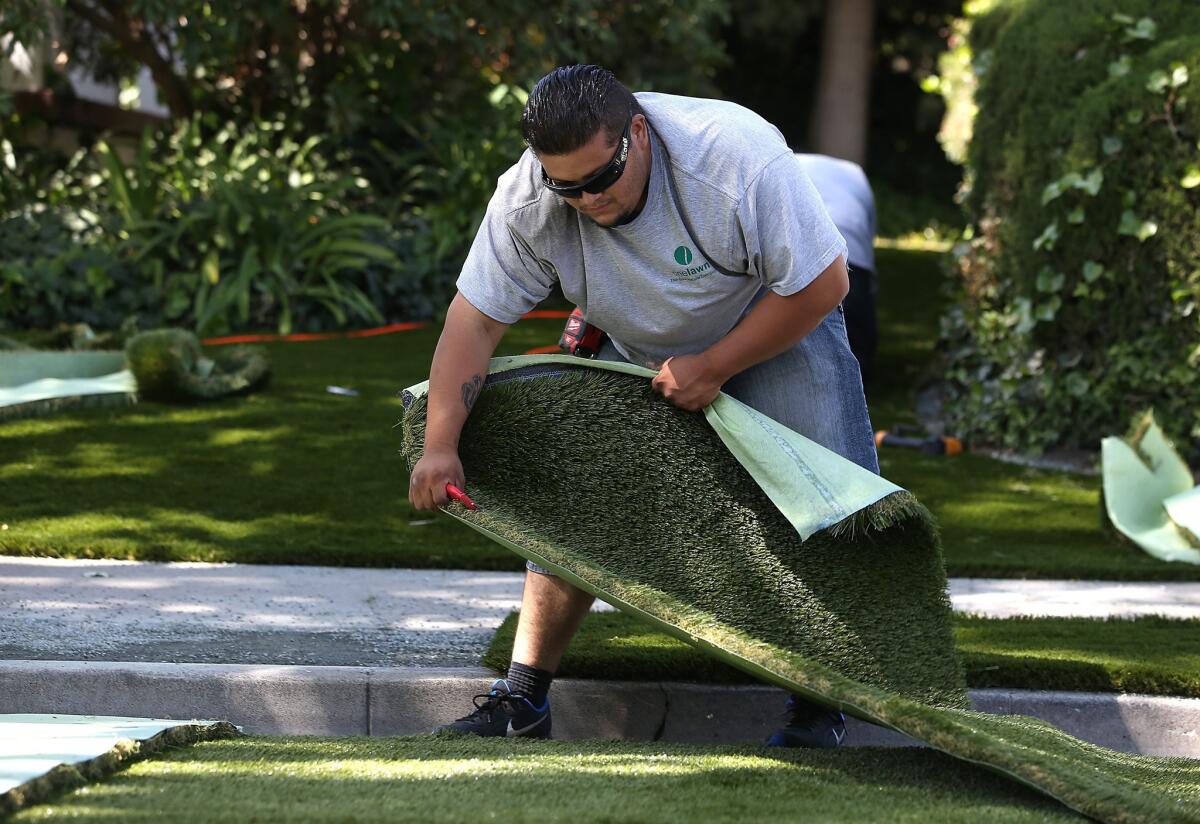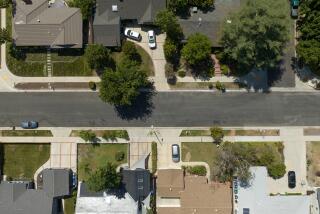The wrong way to think about California water

Juan Martinez of landscaping company Onelawn installs a section of artificial lawn at a home in Burlingame, Calif.
- Share via
Water is complicated. Nowhere is that more true than in California, and never more than during a major drought.
That may be why so much of the debate about how to manage California’s scarce water supply is misguided.
The national press brims with photographs of emerald-green Palm Springs golf courses fenced off from sandy desert. Would-be presidential candidate Carly Fiorina blames the drought on “liberal environmentalists” blocking reservoir construction. Easterners gibe about the folly of growing thirsty almond trees in a dry climate.
But Palm Springs isn’t emblematic of all California, the drought is not man-made and California’s water problems stem at least partially from its role as breadbasket (or nut bowl) for the nation.
So here’s a guide to the wrong ways to think about California water, and the glimmer of a better way.
Industry: It’s not about bottled water. Consider this as a rule of thumb: Whenever you see water use denominated in millions of gallons, in California terms that’s a tiny drop in a very big bucket.
Yet it’s common to see users of tens or hundreds of millions of gallons demonized as perpetrators of the drought or profiteers in the face of statewide calamity. Aljazeera America and Salon last week both fingered Nestle, the owner of Arrowhead and many other bottled-water brands, as a public enemy: “While California sips its scarce water, Nestle gulps,” Aljazeera declared. Salon labeled the company “despicable” for “making a killing — while California is dying of thirst.”
Let’s inject some perspective. The entire nation consumes a bit more than 10 billion gallons of bottled water per year. California’s total water use, according to 2010 figures from the U.S. Geological Survey, is 38 billion gallons per day.
“There are plenty of reasons to avoid bottled water,” says water and climate expert Peter H. Gleick, president of the Pacific Institute and a leading critic of the industry. “It’s got environmental challenges, it’s incredibly expensive, it’s unnecessary, and it’s not as well regulated as tap water.”
In California, bottling plants may be responsible for localized overpumping of groundwater supplies and fail to provide adequate information about their activities; Nestle’s operations on the Morongo reservation are especially opaque, as we reported last summer. These ills need to be rectified.
“They ought to be better regulated,” Gleick says. “But we’re not going to solve the drought by not bottling water.”
Agriculture: Stop talking about the almond trees. Perhaps the best-known statistic about the state’s nut crop is that it takes one gallon of water to grow a single almond. That’s a cute version of the basic statistic, which measures how much water is required to bring an almond orchard to maturity over as long as four years. But many crops require just as much water or more — in excess of five gallons to raise a single head of broccoli, for example — and almost nothing is as demanding as beef.
In any case, the almond harvest was worth $5.8 billion in 2013, second only to milk and ahead of grapes. Walnuts and pistachios ranked sixth and 12th. These may be exactly the crops to which the state should be funneling its scarce water — high-value crops.
“For farmers, [almonds are] one of the highest-value commodities,” says Ellen Hanak, director of the Water Policy Center of the Public Policy Institute of California. Therefore, she says, “the value of the water used on almonds is higher than on most crops.” Fruits and nuts account for 45% of the total revenue of California agriculture, but consume only 34% of agricultural water — the only category for which the share of value is higher than the proportion of water.
“California farmers have been very responsive to economic opportunities,” Hanak says. “It makes me nervous that someone sitting in Sacramento or Washington thinks they’re better judges of what the crop mix should be.”
A better way is to give farmers the incentive to engage in sustainable water use. “I don’t care if they’re growing almonds,” Gleick says, “if they’re not overpumping groundwater and not contaminating water supplies.”
Urban use: The shame of turf. Gov. Jerry Brown has taken heat for supposedly giving farmers a pass in the statewide water use restrictions he imposed April 1, especially since agriculture accounts for about 80% of use. But many farmers already have sustained draconian cutbacks in allocations from state and federal water projects.
There’s still plenty of excess to wring out of residential usage, even though daily urban consumption fell to 178 gallons per capita in 2010 from 232 in 1995, according to the Public Policy Institute of California — thanks largely to low-flow toilets, water-stingy washing machines and water-wise building codes for new construction.
The bloat can be found in outdoor residential use, which accounts for a third of all urban consumption. Ornamental turf lawns, especially in Southern California, should be replaced by succulents and other water-thrifty plants. “We need to look at lawns the way we look at smoking in restaurants,” Gleick says, “as not a good idea anymore.”
There isn’t just one California. Those overwatered Palm Springs golf courses don’t tell you much about California’s drought any more than the nearly full reservoirs in parts of Northern California mean that the drought is mythical. Nor is there a “typical” California farmer: Some have senior water rights dating back 100 years, immunizing them from shortages; some are scrambling to buy every cubic foot they can acquire.
The only lasting solutions include creating a better-functioning water market with transparent pricing and transfers, so that water supplies end up where they’re most needed and most economically useful. The market will never be perfect, because it’s not always simple to move water from one region to another. And regulatory oversight will always be needed to keep users with senior rights from hoarding water, and ensuring that dependent users, whether farmers or city dwellers, aren’t left dry.
Gleick’s Pacific Institute reckons that improved efficiency could save 14 million acre-feet of water annually — more than twice the deficit of statewide usage compared with sustainable supply. (One acre-foot, or 325,851 gallons, is enough to supply a California family of five for a year at current average consumption levels.)
That requires not only Gov. Brown’s mandated reductions, but regulations and perhaps public financing to encourage more efficient crop irrigation. Rules enacted last year by the Legislature aim to stem overpumping of groundwater, particularly by farms in the Central Valley, a significant threat to the state’s long-term water health. But they won’t be fully effective for decades; the drought underscores the importance of accelerating the schedule.
Most important, it may be time to look at the state Constitution’s mandate that all water use be “reasonable and beneficial ... for the public welfare,” and hold farms and big users to that standard.
“If you’re flood-irrigating a crop that could be grown with drip irrigation, I’d argue that you’re not using water reasonably and beneficially,” Gleick says. “The next step is for the state water board to say that.”
Michael Hiltzik’s column appears Sundays and Wednesdays. Read his blog, the Economy Hub, at latimes.com/business/hiltzik, reach him at [email protected], check out facebook.com/hiltzik and follow @hiltzikm on Twitter.
More to Read
Inside the business of entertainment
The Wide Shot brings you news, analysis and insights on everything from streaming wars to production — and what it all means for the future.
You may occasionally receive promotional content from the Los Angeles Times.











